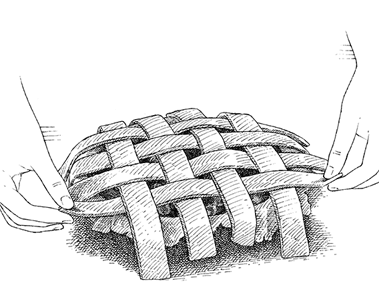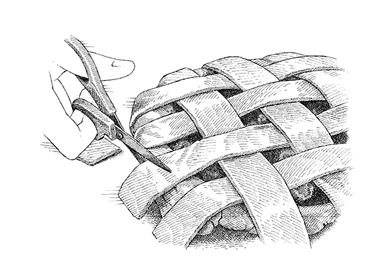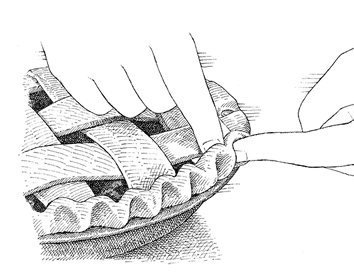The Cook's Illustrated Cookbook (332 page)
Read The Cook's Illustrated Cookbook Online
Authors: The Editors at America's Test Kitchen
Tags: #Cooking

SERVES 8
You can use
FOOLPROOF
,
ALL-BUTTER
, or
CLASSIC DOUBLE-CRUST PIE DOUGH
for this pie. If your peaches are firm, you should be able to peel them with a sharp vegetable peeler. If they are too soft to withstand the pressure of a peeler, you’ll need to blanch them in a pot of simmering water for 15 seconds and then shock them in a bowl of ice water before peeling. For more information on fitting pie dough, see
“FITTING PIE DOUGH”
.
1 | |
2¹⁄ | pounds peaches, peeled, halved, pitted, and sliced ¹⁄ |
1 | cup (7 ounces) plus 1 tablespoon sugar |
1 | tablespoon cornstarch |
1 | tablespoon lemon juice |
Pinch ground cinnamon | |
Pinch ground nutmeg | |
Pinch salt | |
1 | large egg white, lightly beaten |
1.
Roll 1 disk of dough into 12-inch circle on lightly floured counter. Loosely roll dough around rolling pin and gently unroll it onto 9-inch pie plate, letting excess dough hang over edge. Ease dough into plate by gently lifting edge of dough with 1 hand while pressing into plate bottom with other hand. Leave any dough that overhangs plate in place. Wrap dough-lined pie plate loosely in plastic wrap and refrigerate until dough is firm, about 30 minutes.
2.
Roll other disk of dough into 13¹⁄
2
by 10¹⁄
2
-inch rectangle on lightly floured counter, then transfer to parchment paper–lined baking sheet. Trim dough to 13 by 10-inch rectangle and slice lengthwise into eight 13-inch-long strips. Separate strips slightly, cover with plastic, and freeze until very firm, about 30 minutes.
3.
Toss peaches and 1 cup sugar together in large bowl and let sit, tossing occasionally, until peaches release their juice, about 1 hour. Adjust oven rack to lowest position, place rimmed baking sheet on rack, and heat oven to 425 degrees.
4.
Drain peaches thoroughly in colander, reserving ¹⁄
4
cup of juice. In large bowl, toss drained fruit, reserved juice, cornstarch, lemon juice, cinnamon, nutmeg, and salt together until well combined.
5.
Spread peaches into dough-lined pie plate. Lay 4 parallel strips of chilled dough evenly over filling. Weave remaining strips in opposite direction, one at a time, to create lattice (if dough becomes too soft to work with, refrigerate pie and dough strips until dough firms up). Let strips soften for 5 to 10 minutes, then trim overhang to ¹⁄
2
inch beyond lip of pie plate. Pinch edges of crust and lattice strips together, then tuck overhang under itself; folded edge should be flush with edge of pie plate. Crimp dough evenly around edge of pie using fingers. Brush lattice with beaten egg white and sprinkle evenly with remaining 1 tablespoon sugar.
6.
Place pie on heated baking sheet and bake until top crust is light golden brown, about 25 minutes. Reduce oven temperature to 375 degrees, rotate baking sheet, and continue to bake until juices are bubbling and crust is deep golden brown, 25 to 35 minutes longer. Let pie cool on wire rack until filling has set, about 2 hours; serve slightly warm or at room temperature.

1.
Lay 4 parallel strips evenly over filling. Weave fifth strip in opposite direction, lifting strips as needed to make weaving easier.

2.
Continue to weave in remaining 3 strips, one at a time, to create lattice.

3.
After letting strips soften, trim overhanging edges of dough to ¹⁄
2
inch beyond lip of pie plate. Press edges of bottom crust and lattice strips together and tuck underneath.

4.
Create fluted edge around pie, using index finger of 1 hand and thumb and index finger of other.
![]() WHY THIS RECIPE WORKS
WHY THIS RECIPE WORKS
Because uncooked berries shed so much liquid, the filling for strawberry pie is usually firmed up with some sort of thickener, which produces results that range from stiff and bouncy to runny and gloppy. We wanted a recipe for our ideal strawberry pie, featuring fresh berries lightly held together by a sheer, glossy glaze that made their flavor pop in the buttery shell. We knew that the success of our strawberry pie hinged on getting the thickener just right. When none of the thickeners we tried worked on their own, we decided to use a combination of two: pectin (in the form of a homemade strawberry jam) and cornstarch. By themselves, pectin produced a filling that was too firm and cornstarch one that was too loose. But together they created just the right supple, lightly clingy glaze.
SERVES 8
You can use
FOOLPROOF
,
ALL-BUTTER
, or
CLASSIC SINGLE-CRUST PIE DOUGH
for this pie. To account for any imperfect strawberries, the ingredient list calls for several more ounces of berries than will be used in the pie. If possible, seek out ripe, farmers’ market–quality berries. Make sure to thoroughly dry the strawberries after washing. Make certain that you use Sure-Jell engineered for low- or no-sugar recipes (packaged in a pink box) and not regular Sure-Jell (in a yellow box); otherwise, the glaze will not set properly. The pie is at its best after two or three hours of chilling; as it continues to chill, the glaze becomes softer and wetter, though the pie will taste just as good.
3 | pounds strawberries, hulled (9 cups) |
³⁄ | cup (5¹⁄ |
2 | tablespoons cornstarch |
1¹⁄ | teaspoons Sure-Jell for low-sugar recipes |
Pinch salt | |
1 | tablespoon lemon juice |
1 | recipe |
1.
Select 6 ounces misshapen, underripe, or otherwise unattractive berries, halving those that are large; you should have about 1¹⁄
2
cups. Process berries in food processor to smooth puree, 20 to 30 seconds, scraping down bowl as needed (you should have about ³⁄
4
cup puree).
2.
Whisk sugar, cornstarch, Sure-Jell, and salt together in medium saucepan. Stir in berry puree, making sure to scrape corners of pan. Cook over medium-high heat, stirring constantly, and bring to boil. Boil, scraping bottom and sides of pan to prevent scorching, for 2 minutes to ensure that cornstarch is fully cooked (mixture will appear frothy when it first reaches boil, then will darken and thicken with further cooking). Transfer glaze to large bowl and stir in lemon juice; let cool to room temperature.
3.
Meanwhile, pick over remaining berries and measure out 2 pounds of most attractive ones; halve only extra-large berries. Add berries to bowl with glaze and fold gently with rubber spatula until berries are evenly coated. Scoop berries into cooled prebaked pie shell, piling into mound. If any cut sides face up on top, turn them face down. If necessary, rearrange berries so that holes are filled and mound looks attractive. Refrigerate pie until filling is chilled and has set, about 2 hours. Serve within 5 hours of chilling.
![]() WHY THIS RECIPE WORKS
WHY THIS RECIPE WORKS
A fresh berry pie might seem like an easy-to-pull-off summer dessert, but most of the recipes we tried buried the berries in gluey thickeners or embedded them in bouncy gelatin. Our goal was to make a pie with great texture and flavor—and still keep it simple.
We started with the test kitchen’s quick and easy homemade graham cracker crust, which relies on crushed graham crackers (store-bought graham cracker crumbs often taste stale). For the filling, we used a combination of raspberries, blackberries, and blueberries. After trying a few different methods, we found a solution that both bound the berries in the graham cracker crust and intensified their bright flavor. We processed a portion of berries in a food processor until they made a smooth puree, then we thickened the puree with cornstarch. Next, we tossed the remaining berries with warm jelly for a glossy coat and a shot of sweetness. Pressed gently into the puree, the berries stayed put and tasted great.
